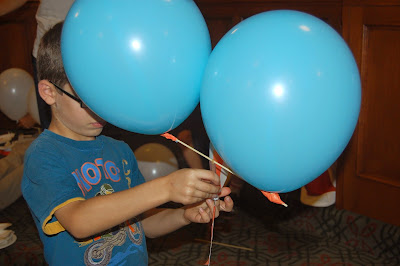Building a Balanced Dinosaur
On Thursday, August 25th, while the rest of the library was closed early, kids and their parents were hanging out here in the children's Story Room learning about paleontology and center of gravity, and building their own dinosaurs!
I showed a slide show about how scientists' concepts of dinosaurs has changed over the years, particularly when we think about how a dinosaur would have stood or walked. Based on scientists' knowledge of anatomy and the weight of dinosaur bones, they've come to the conclusion that most dinosaurs had tails that stuck straight out, and provided balance while holding their heads and upper bodies in a forward (not upright!) position.
Then we took a wide variety of materials, including toilet paper tubes, cardboard, tape, plastic straws, pipe cleaners, and a few colorful and fun materials like feathers and googly eyes, and made dinosaurs that stood at least 6" tall with good balance.
Kids used counterweights and tried different design ideas to get their dinosaurs to stand stable. Sometimes they had to add weight to the head, or to the tail. Sometimes they had to make sturdier legs or hips. They put a lot of thought into their work, as I hope our video shows:
From our photos you see kids had a wide range of design ideas, all of which worked splendidly!
It's easy to start learning and applying science and engineering concepts with the awesome website CuriosityMachine.org. There are educational videos to teach the concepts behind each challenge, and all of the challenges are easy to do with materials you have around the house. Sign up and start creating!
Want to read more about dinosaurs? Check out these great books!
Feathered Dinosaurs by Thom & Laurie Holmes. Explores the connection between birds and dinosaurs, details the time and areas where these dinosaurs roamed, as well as what they ate and how they behaved, and discusses major related fossil discoveries.
Dino Wars by Jimmy Johnson. "Discover the deadliest dinosaurs, bloodiest battles, and super survival strategies of the prehistoric world"--Cover.
Dinosaur by David Lambert (Eyewitness series). Discusses the environment in which dinosaurs lived, the characteristics of different types of dinosaurs, the disappearance of these creatures, and how scientists learn from their fossil remains.
The Dinosaurs of Waterhouse Hawkins by Barbara Kerley and illustrated by Brian Selznick. The true story of Victorian artist Benjamin Waterhouse Hawkins, who built life-sized models of dinosaurs in the hope of educating the world about what these awe-inspiring ancient animals and what they were like.
Paleontologists and Archaeologists by Ruth Owen
How Big Were Dinosaurs? by Lita Judge. "Dinosaurs and modern life collide in a very young picture book that clearly illustrates how big dinosaurs really were"-- Provided by publisher.
Dinosaurs by Arnaud Plumeri (graphic novels with true facts). Paleontologist Indina Jones provides facts and uncovers mysteries about dinosaurs in this zany graphic novel.
Dinosaurs (World Book Encyclopedia) by Mike Benton. Introduces, in text and illustrations, the characteristics, habits, and natural environment of dinosaurs. Includes experiments and other activities.
Curious about Fossils by Kate Waters. Curious about Fossils explains why and where fossils form and looks at the colorful lives and important discoveries of some of the great early fossil hunters and collectors. Then the adventure continues into modern times, where scientists on fossil hunts in places like North Dakota's Hell Creek Formation use computers and other technology to dig up the fossilized bones, teeth, and even poop that provide clues to the past.
Did Dinosaurs Have Feathers? by Kathleen Weidner Zoehfield. Discusses the discovery and analysis of Archaeopteryx, a feathered dinosaur which may have been an ancestor of modern birds.
Collecting Fossils by Steve & Jane Parker. Presents information on how and where to find fossils, the preparation and tools needed for collecting them, and how to identify the various kinds: plant, invertebrate, and vertebrate.
Bizarre Dinosaurs by Christopher Sloan. Uses clear and informed text to tell readers what scientists know and what they are still guessing about a collection of odd-looking monsters, including how experts think these dinosaurs used their individual, bizarre characteristics.
Grave Secrets of Dinosaurs by Phillip Manning. This adult book was the main resource and inspiration for me while I was learning as much as I could so that I could present information about dinosaurs accurately.
Feathered Dinosaurs by Don Lessem.
We'll have another hands-on science program for tweens (8-12 years old) at Central Library on November 18, in a theme aligning with our Young Reader's League selection (to be announced soon!).















Comments
Post a Comment